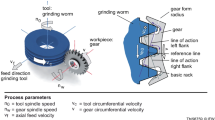Abstract
In internal grinding with axial feed, each double pass begins with insertion of the grinding wheel in the workpiece in the reversing zone, by means of a radial insertion feed; the axial feed in this process is zero. Therefore, at that stage, the cutting conditions are fundamentally different than in machining the remainder of the hole, when the axial feed is nonzero. As a result, in the reversing zone, the quality of machining is significantly different from that for the remainder of the surface. A methodology is considered for optimization of the parameters at wheel insertion, for the example of internal grinding with axial tool feed. Dynamic programming is used for optimization.

Similar content being viewed by others
REFERENCES
Pereverzev, P.P. and Akintseva, A.V., Mathematical model for the internal grinding process of a non-circular hole machining, Procedia Eng., 2016, vol. 150, pp. 1118–1123.
Ardashev, D.V., Anel’chik, D.E., Butorin, G.I., et al., Rezhimy rezan’ya na raboty, vypolnyaemye na shlifoval’nykh i dovodochnykh stankakh s ruchnym upravleniem i poluavtomatakh (Cutting Regimes for Grinding and Finishing Machines with Manual and Semi-Automatic Control), Chelyabinsk: Atokso, 2007.
Obshchemashinostroitel’nye normativy rezhimov rezaniya dlya tekhnicheskogo normirovaniya rabot na metallorezhushchikh stankakh. Chast’ 3. Protyazhnye, shlifoval’nye i dovodochnye stanki (General Machine engineering Standards of Cutting Regimes for Technical Standardization of Operations on Metal Cutting Machines, Part 3: Broaching, Grinding, and Finishing Machines), Moscow: Mashinostroenie, 1978.
Malkin, S. and Guo, C., Theory and Applications of Machining with Abrasives: Grinding Technology, New York: Industrial Press, 2008.
Inasaki, I., Monitoring and optimization of internal grinding process, CIRP Ann., 1991, vol. 400, pp. 359–363.
Alagumurthi, N., Panairadja, K., and Soundararajan, V., Optimization of grinding process through design of experiment (DOE)—a comparative study, Mater. Manuf. Process., 2006, vol. 21, no. 1, pp. 19–21.
Lur’e, G.B., Optimization of the grinding cycle based on adaptive control, Mashinostroitel’, 1979, no. 3, pp. 12–14.
Dong, S., Danai, K., Malkin, S., and Deshunukh, A., Continuous optimal in feed control for cylindrical plunge grinding. Part 1: Methodology, J. Manuf. Sci. Eng., 2004, vol. 126, no. 2, pp. 327–333.
Amitay, G., Malkin, S., and Koren, Y., Adaptive control optimization of grinding, J. Eng. Ind., 1981, vol. 103, pp. 103–108.
Phan, A.M., Summers, M.P., and Parmigiani, J.P., Optimization device for grinding media performance parameters, ASME 2012 Int. Mechanical Engineering Congr. and Exposition, New York, NY: Am. Soc. Mech. Eng., 2012, vol. 3, pp. 915–923.
Bellman, R., Dynamic Programming, Princeton, NJ: Princeton Univ. Press, 1957.
Pereverzev, P.P. and Akintseva, A.V., Automatic cycles multi-parametric optimization of internal grinding, Procedia Eng., 2015, vol. 129, pp. 121–126.
Author information
Authors and Affiliations
Corresponding authors
Additional information
Translated by B. Gilbert
About this article
Cite this article
Akintseva, A.V., Prokhorov, A.V. & Omel’chenko, S.V. Optimizing the Internal-Grinding Cycle at the Insertion Stage. Russ. Engin. Res. 40, 514–517 (2020). https://doi.org/10.3103/S1068798X20060040
Received:
Revised:
Accepted:
Published:
Issue Date:
DOI: https://doi.org/10.3103/S1068798X20060040



